Design and Construction of the Optical Bench Interferometer for the Taiji Program
Abstract
1. Introduction
2. The Design of the OBI
3. The Construction of the OBI
3.1. HCB
3.2. Precision Clamping Mechanism
3.3. Beam Position Measuring Device (BPMD)
3.4. OBI Installation and Adjustment
- The Zerodur® baseplate is placed on the CMM, and under it is a hexapod, which raises and levels the OBI to facilitate subsequent measurement of the beam position by the BPMD. The hexapod can load 30 kg, and it has a power-off hold function, so the power can be cut off after adjusting the substrate position within a certain range.
- Place the template for the initial positioning of the glass block on the Zerodur® baseplate. Use the CMM to measure the position of the template and the position of each glass block to ensure that the position deviation is less than 5 μm. The glass blocks (such as BSa1, PBS1, PBS3, etc.) on the OBI with little influence on the optical path and low sensitivity were bonded through hydroxide catalysis, and 0.8 μL sodium silicate solution was used for each glass block.
- For optical components with a large influence on the optical path and high sensitivity (such as BS3, BS5, BS6, etc.), the positioning accuracy of the template is not enough, and it is necessary to use the precision clamping mechanism to assist the installation and adjustment. Using the mechanical arm to move the glass block within 2 mm of the intended bonding position and at a height of approximately 3 mm from the Zerodur® baseplate, the glass is pressed down on the Zerodur® baseplate by finger 4, located at the top of the glass block (Figure 9), so that the bottom surface of the glass block is contacted to the surface of the Zerodur® baseplate. Finger 4 is then pushed back (about 1 μm away). Adjust fingers 1, 2, and 3 for small movement and rotation of the glass block on the Zerodur® baseplate. After adjusting the position of the glass block to the specified position, use the mechanical arm to lift the whole glass block, use the pipette gun to drop 0.8 μL solution on the Zerodur® baseplate, and then operate the mechanical arm to reset down to the position 2 mm away from the substrate. At this time, the position of the glass block has a small deviation from the ideal position, which is determined by the reset accuracy of the mechanical arm. Use fingers 1, 2, and 3 to re-adjust the glass block to the specified position, and, finally, use finger 4 to press the glass block down to make full contact with the substrate and hold the solution between the two. After maintaining this state for 24 h, the bond already has a higher strength. Then, slowly back the four fingers more than 1 cm apart; because the clamping force is very small (only about 1.2 N), this will not destroy the bonding. Then, slowly move the mechanical arm away from the glass block completely to complete the bonding.
4. Stability Testing
5. Conclusions and Outlook
Author Contributions
Funding
Institutional Review Board Statement
Informed Consent Statement
Data Availability Statement
Acknowledgments
Conflicts of Interest
References
- Abbott, B.; Abbott, R.; Abbott, T.D.; Abernathy, M.R.; Acernese, F.; Ackley, K.; Adams, C.; Adams, T.; Addesso, P.; Adhikari, R.X.; et al. LIGO Scientific Collaboration and Virgo Collaboration (2016) Directly comparing GW150914 with numerical solutions of Einstein’s equations for binary black hole coalescence. Phys. Rev. D 2016, 94, 064035. [Google Scholar] [CrossRef]
- Collaboration, L.S.; Virgo, C.; Abbott, B.P.; Abbott, R.; Abbott, T.D.; Abernathy, M.R.; Acernese, F.; Ackley, K.; Adams, C.; Adams, T.; et al. Observation of Gravitational Waves from a Binary Black Hole Merger. Phys. Rev. Lett. 2016, 116, 061102. [Google Scholar] [CrossRef]
- Luo, Z.R.; Wang, Y.; Wu, Y.L.; Hu, W.R.; Jin, G. The Taiji program: A concise overview. Prog. Theor. Exp. Phys. 2021, 2021, 9. [Google Scholar] [CrossRef]
- Xia, Y.; Li, G.Y.; Heinzel, G.; Rüdiger, A.; Luo, Y.J. Orbit design for the Laser Interferometer Space Antenna (LISA). Sci. China-Phys. Mech. Astron. 2010, 53, 179–186. [Google Scholar] [CrossRef]
- Bayle, J.B.; Bonga, B.; Caprini, C.; Doneva, D.; Muratore, M.; Petiteau, A.; Rossi, E.; Shao, L.J. Overview and progress on the Laser Interferometer Space Antenna mission. Nat. Astron. 2022, 6, 1334–1338. [Google Scholar] [CrossRef]
- Armano, M.; Audley, H.; Baird, J.; Binetruy, P.; Born, M.; Bortoluzzi, D.; Brandt, N.; Castelli, E.; Cavalleri, A.; Cesarini, A.; et al. Sensor noise in LISA Pathfinder: An extensive in-flight review of the angular and longitudinal interferometric measurement system. Phys. Rev. D 2022, 106, 34. [Google Scholar] [CrossRef]
- Gao, R.H.; Liu, H.S.; Zhao, Y.; Luo, Z.R.; Jin, G. Automatic, high-speed, high-precision acquisition scheme with QPD for the Taiji program. Opt. Express 2021, 29, 821–836. [Google Scholar] [CrossRef] [PubMed]
- Beveridge, N.L. Characterisation of Silicon-Silicon Hydroxide Catalysis Bonds for Future Gravitational Wave Detectors. Ph.D. Thesis, University of Glasgow, Glasgow, UK, 2012. [Google Scholar]
- Robertson, D.I.; Fitzsimons, E.D.; Killow, C.J.; Perreur-Lloyd, M.; Ward, H.; Bryant, J.; Cruise, A.M.; Dixon, G.; Hoyland, D.; Smith, D.; et al. Construction and testing of the optical bench for LISA Pathfinder. Class. Quantum Gravity 2013, 30, 13. [Google Scholar] [CrossRef]
- Armano, M.; Audley, H.; Auger, G.; Baird, J.T.; Bassan, M.; Binetruy, P.; Born, M.; Bortoluzzi, D.; Brandt, N.; Caleno, M.; et al. Sub-Femto-g Free Fall for Space-Based Gravitational Wave Observatories: LISA Pathfinder Results. Phys. Rev. Lett. 2016, 116, 10. [Google Scholar] [CrossRef] [PubMed]
- Armano, M.; Audley, H.; Baird, J.; Binetruy, P.; Born, M.; Bortoluzzi, D.; Castelli, E.; Cavalleri, A.; Cesarini, A.; Cruise, A.M.; et al. Beyond the Required LISA Free-Fall Performance: New LISA Pathfinder Results down to 20 μHz. Phys. Rev. Lett. 2018, 120, 7. [Google Scholar] [CrossRef] [PubMed]
- Preston, A.; Thorpe, J.I.; Miner, L.; IEEE. Quasi-monolithic structures for spaceflight using hydroxide-catalysis bonding. In Proceedings of the IEEE Aerospace Conference, Big Sky, MT, USA, 3–10 March 2012. [Google Scholar]
- Vitale, S. Space-borne gravitational wave observatories. Gen. Relativ. Gravit. 2014, 46, 19. [Google Scholar] [CrossRef]
- Wang, S.W.; Lipa, J.A.; Gwo, D.H.; Triebes, K.; Turneaure, J.P.; Farley, R.P.; Davidson, D.; Bower, K.A.; Acworth, E.B.; Bernier, R.J.; et al. The design and performance of the Gravity Probe B telescope. Class. Quantum Gravity 2015, 32, 34. [Google Scholar] [CrossRef]
- Chwalla, M.; Danzmann, K.; Alvarez, M.D.; Delgado, J.J.E.; Barranco, G.F.; Fitzsimons, E.; Gerberding, O.; Heinzel, G.; Killow, C.J.; Lieser, M.; et al. Optical Suppression of Tilt-to-Length Coupling in the LISA Long-Arm Interferometer. Phys. Rev. Appl. 2020, 14, 14. [Google Scholar] [CrossRef]
- Chwalla, M.; Danzmann, K.; Fernández Barranco, G.; Fitzsimons, E.; Gerberding, O.; Heinzel, G.; Killow, C.J.; Lieser, M.; Perreur-Lloyd, M.; Robertson, D.I.; et al. Design and construction of an optical test bed for LISA imaging systems and tilt-to-length coupling. Class. Quantum Gravity 2016, 33, 245015. [Google Scholar] [CrossRef]
- van Veggel, A.M.A.; Killow, C.J. Hydroxide catalysis bonding for astronomical instruments. Adv. Opt. Technol. 2014, 3, 293–307. [Google Scholar] [CrossRef]
- Elliffe, E.J.; Bogenstahl, J.; Deshpande, A.; Hough, J.; Killow, C.; Reid, S.; Robertson, D.; Rowan, S.; Ward, H.; Cagnoli, G. Hydroxide-catalysis bonding for stable optical systems for space. Class. Quantum Gravity 2005, 22, S257–S267. [Google Scholar] [CrossRef]
- Heinzel, G.; Wand, V.; García, A.; Jennrich, O.P.; Braxmaier, C.; Robertson, D.; Middleton, K.; Hoyland, D.; Rüdiger, A.; Schilling, R.; et al. The LTP interferometer and phasemeter. Class. Quantum Gravity 2004, 21, S581–S587. [Google Scholar] [CrossRef][Green Version]
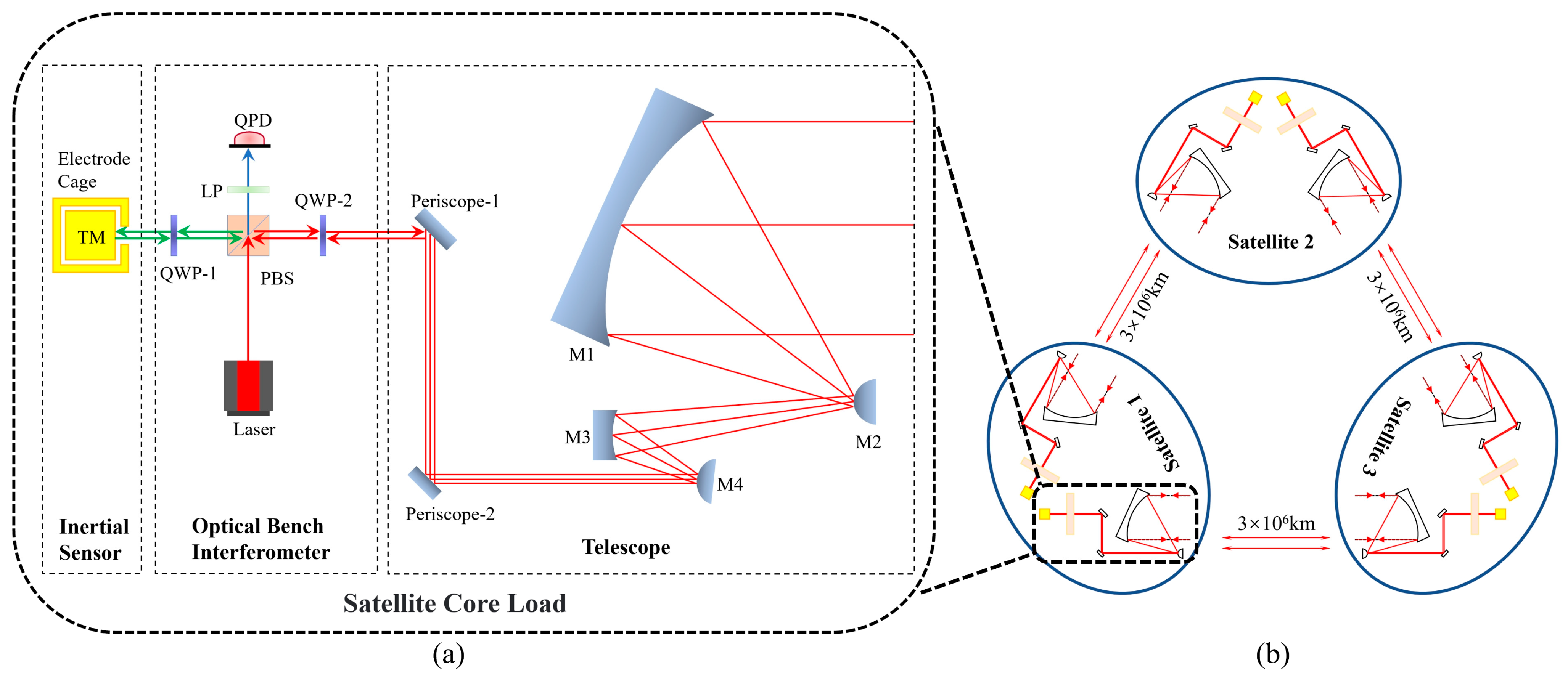
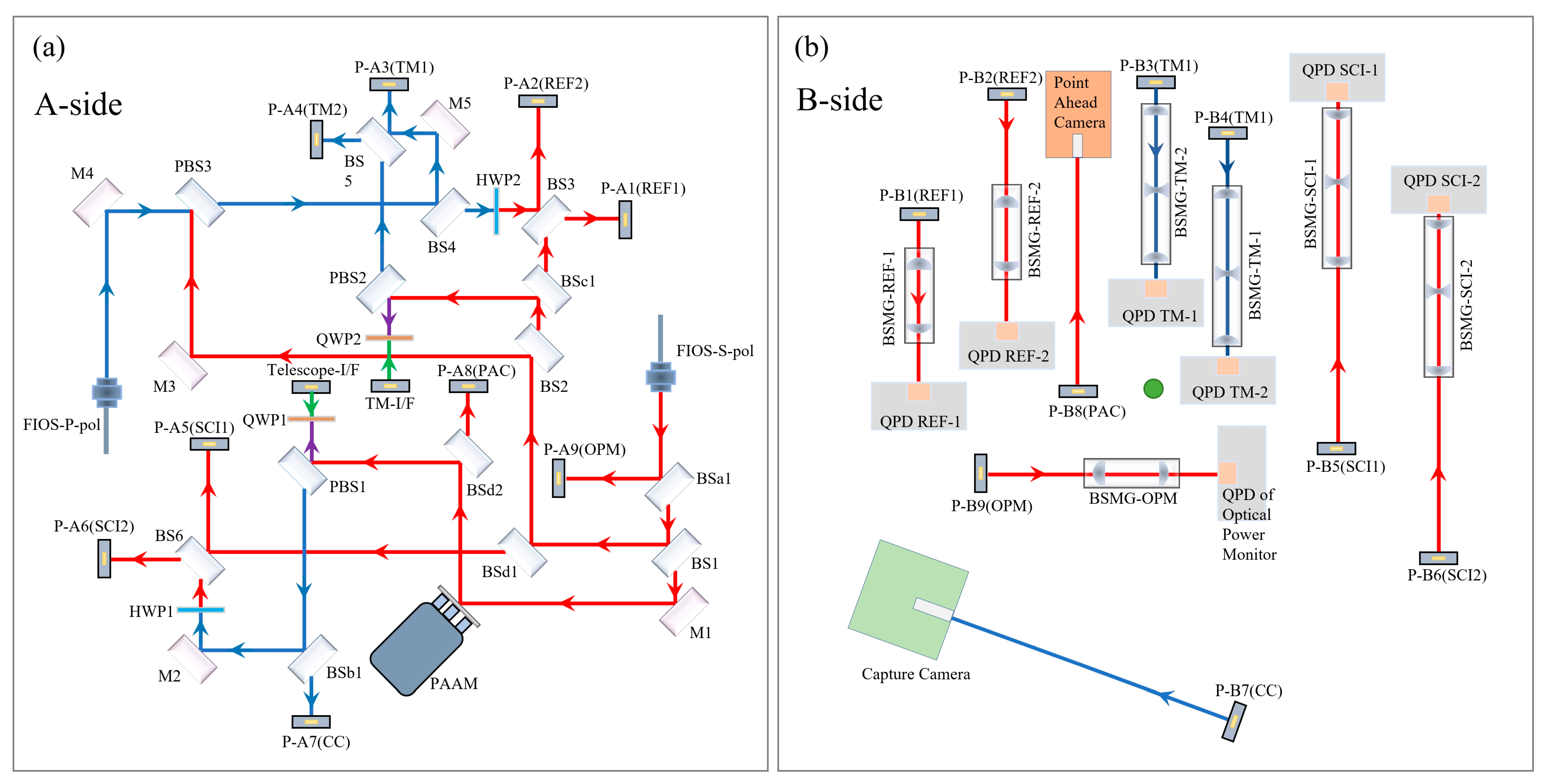
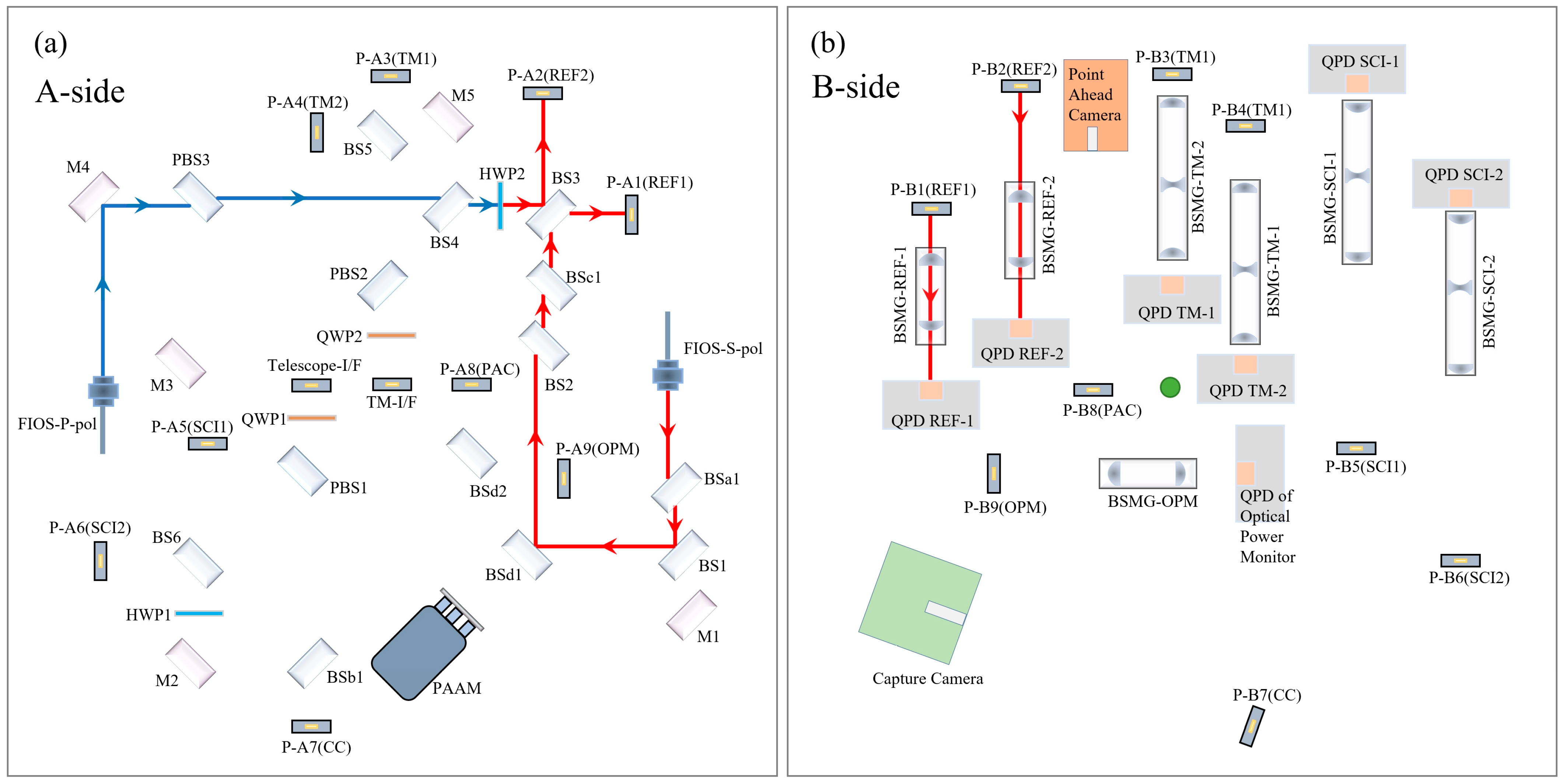

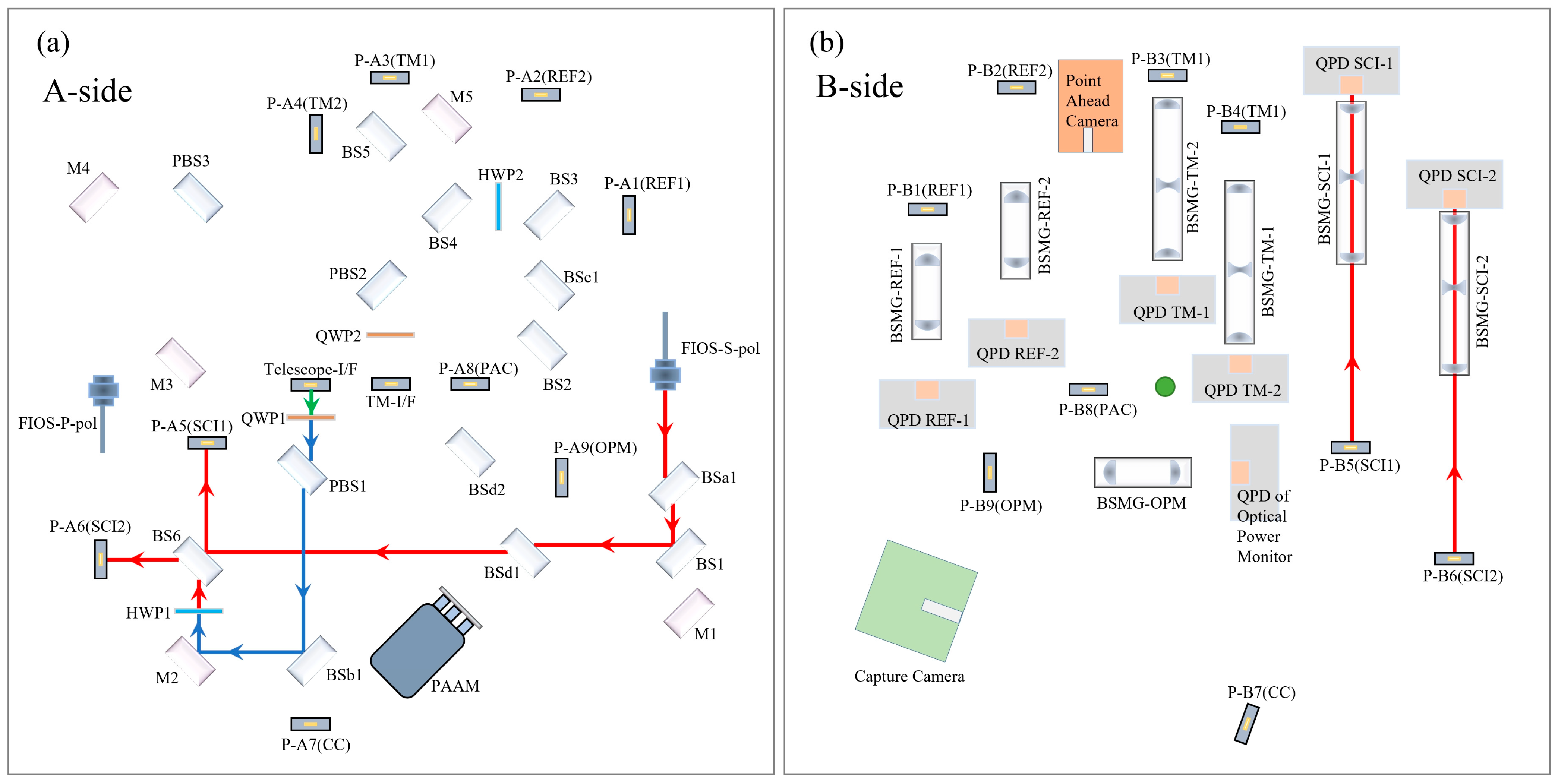
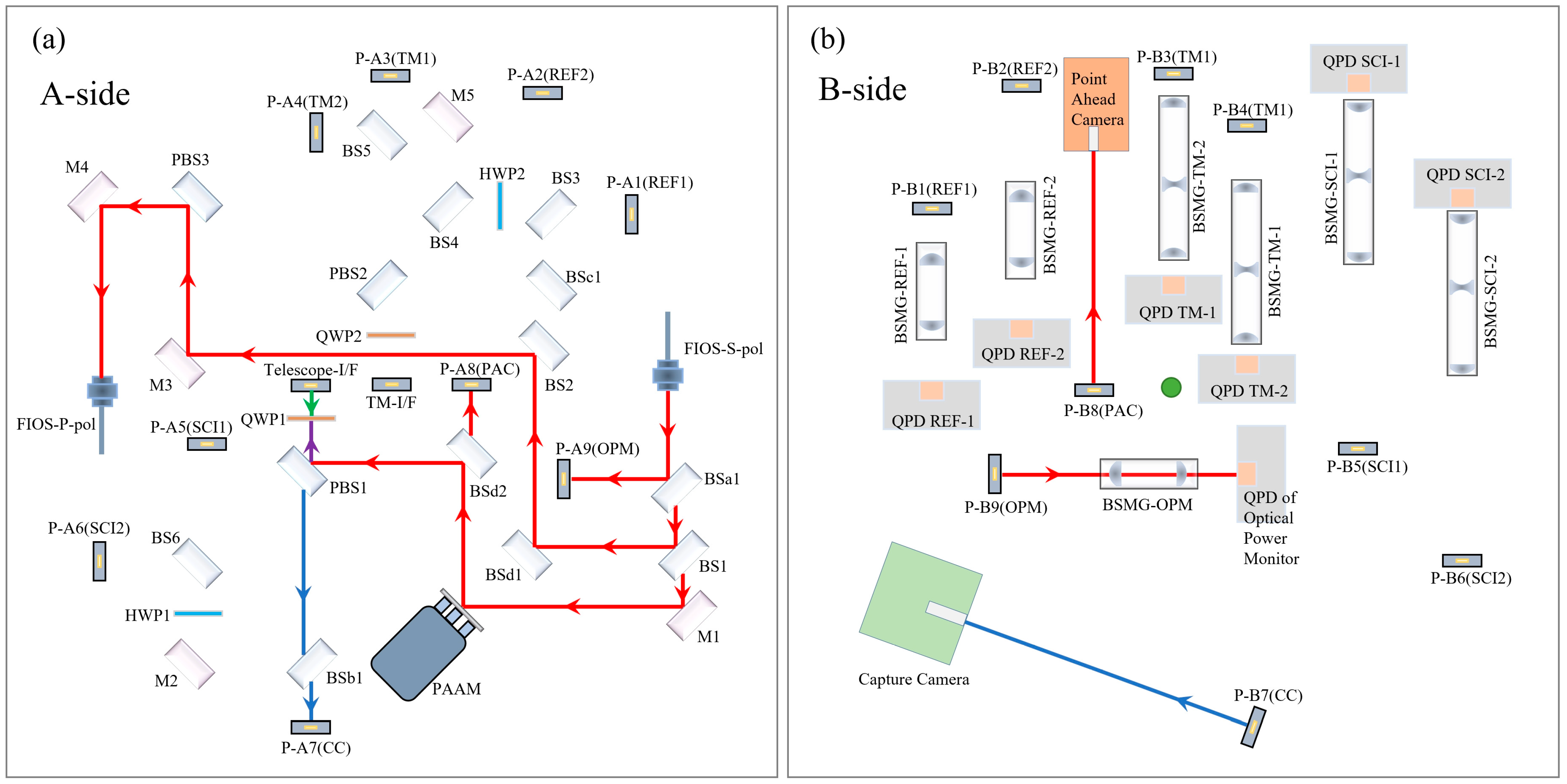
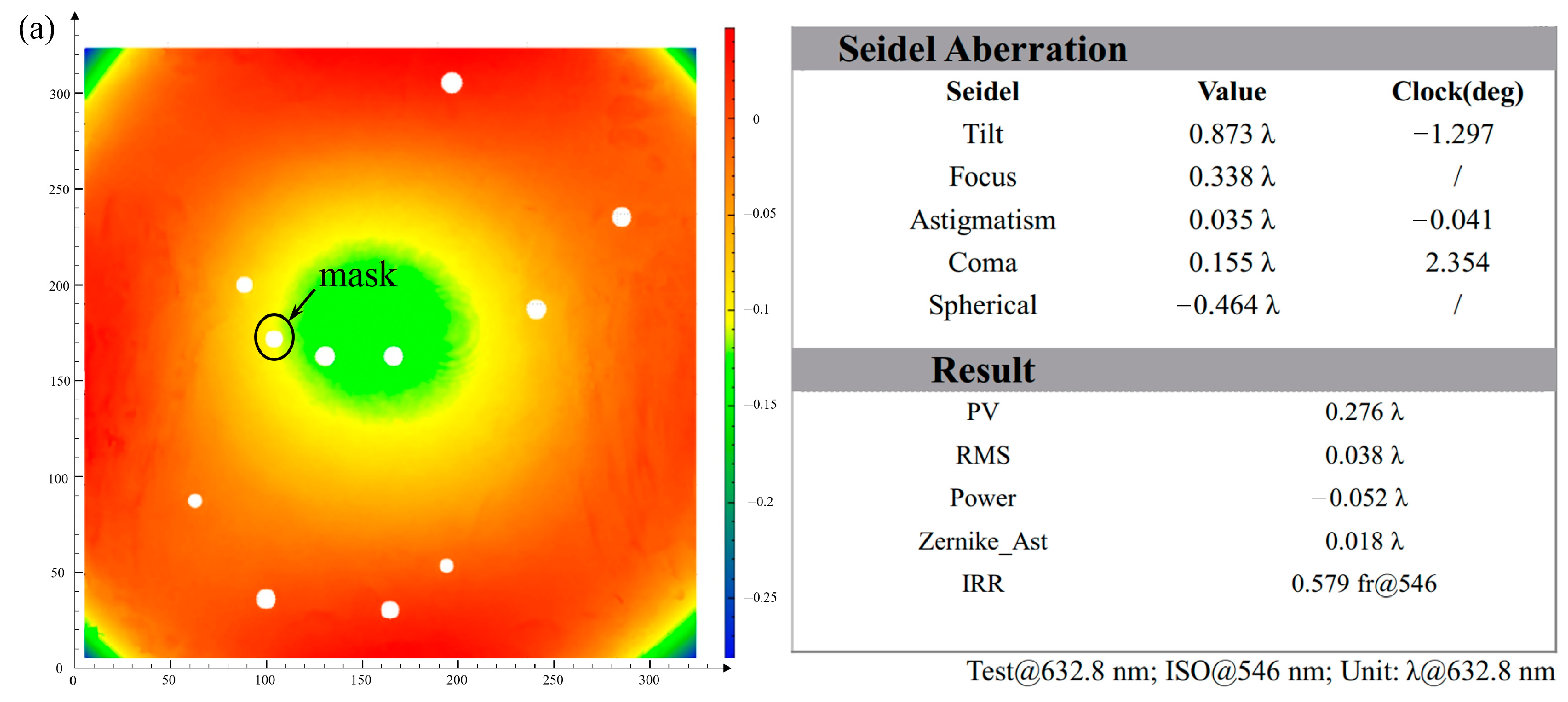
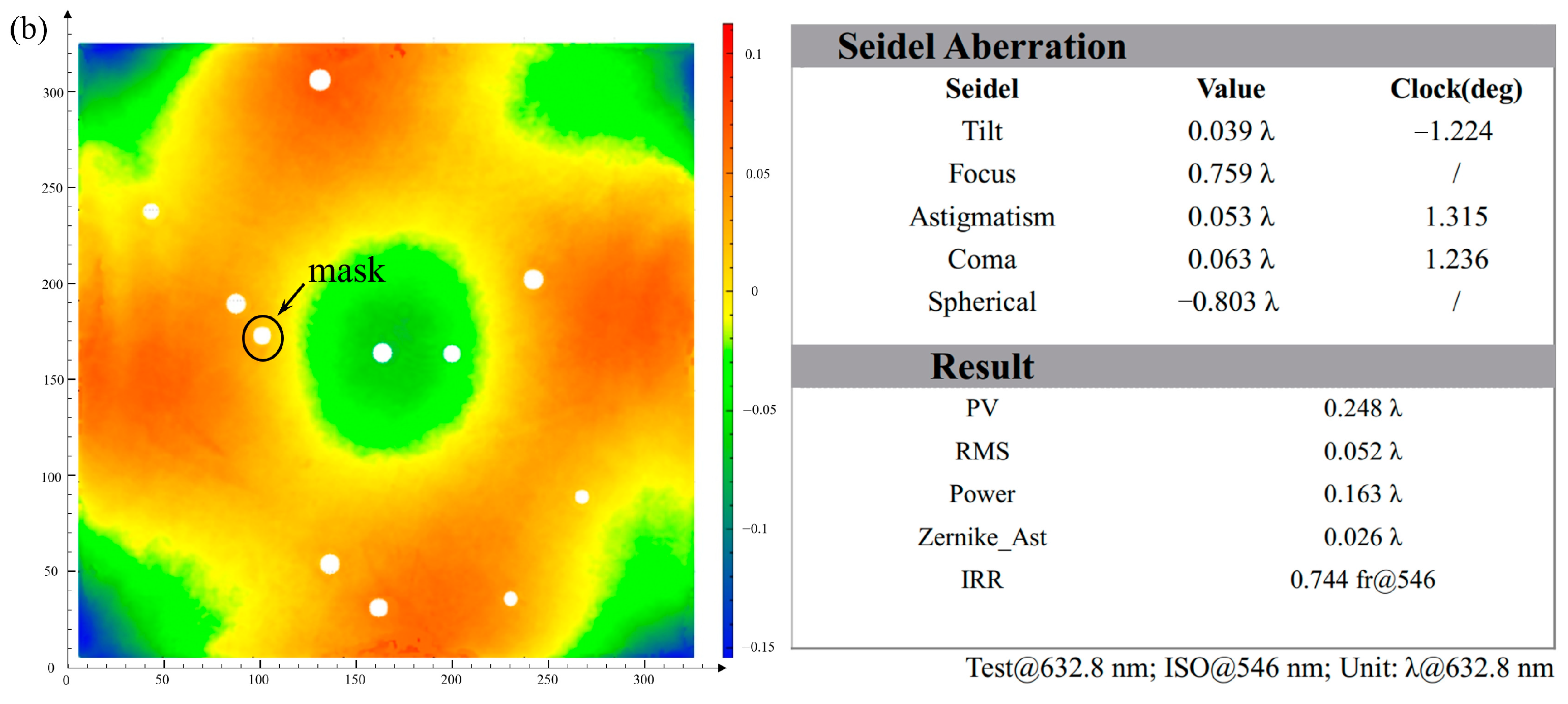


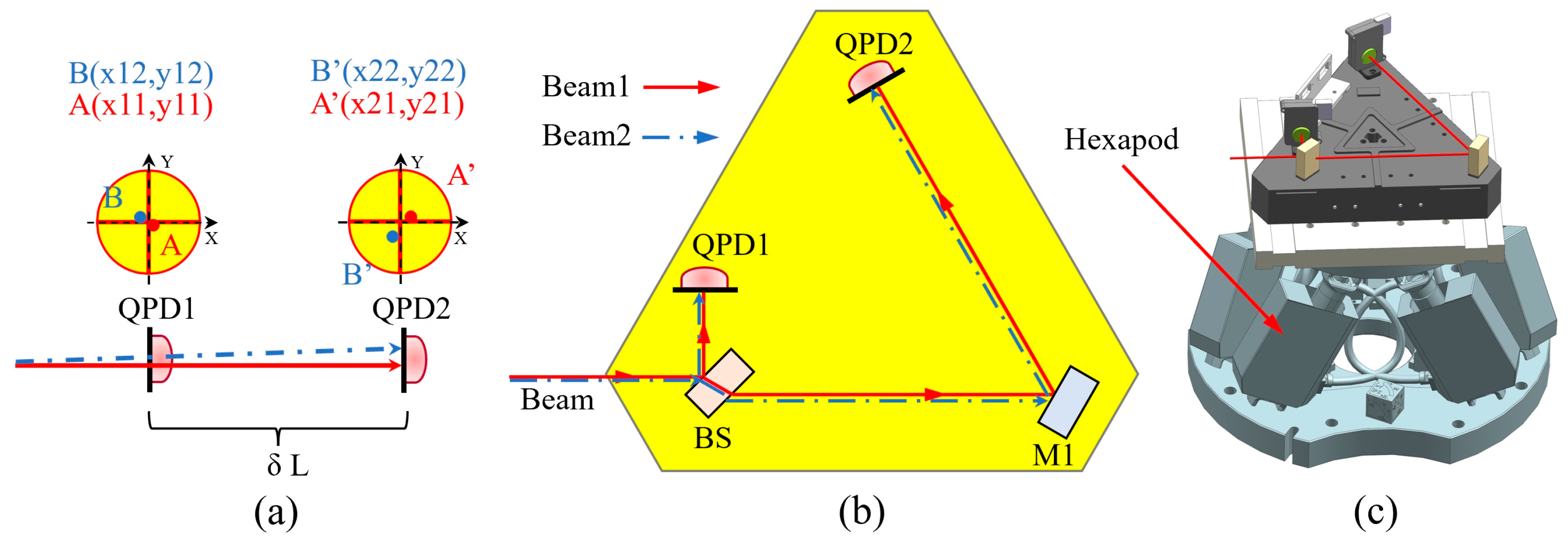

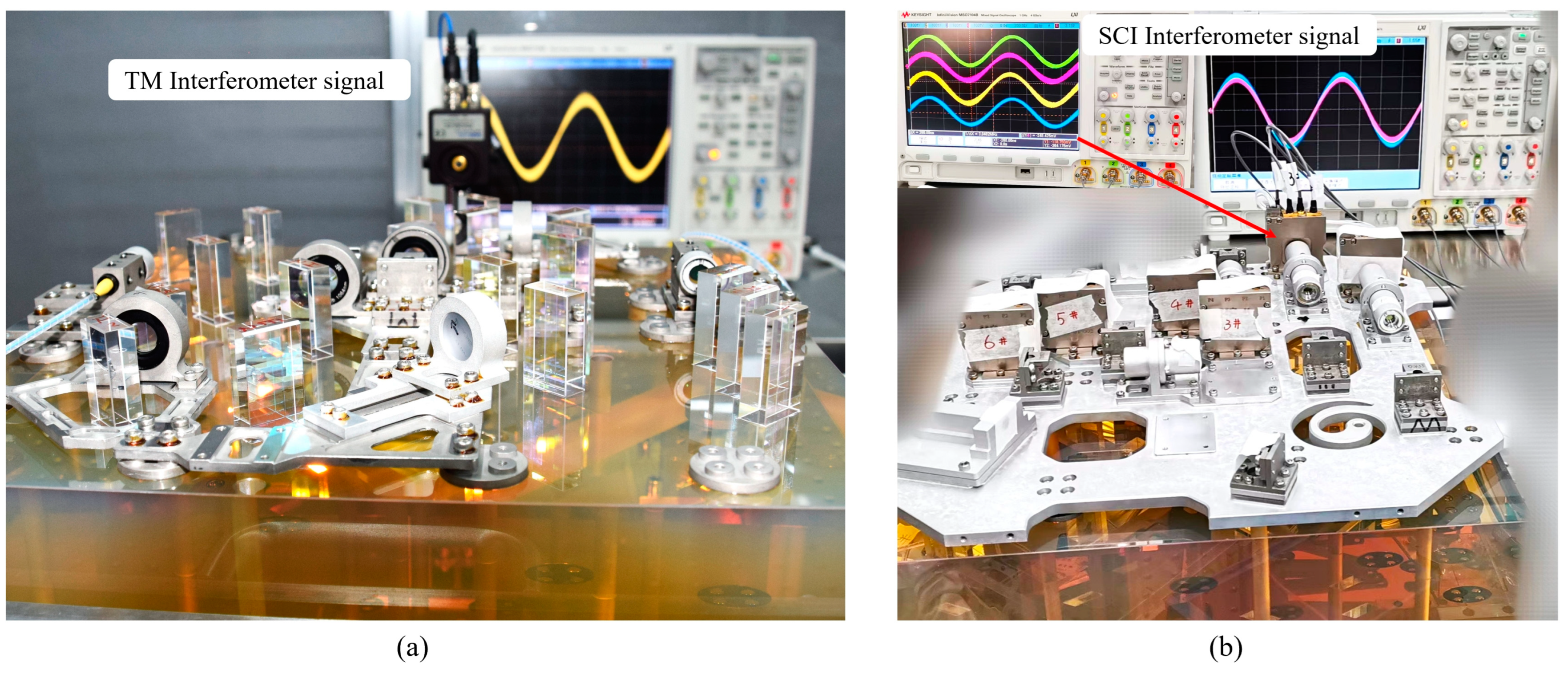



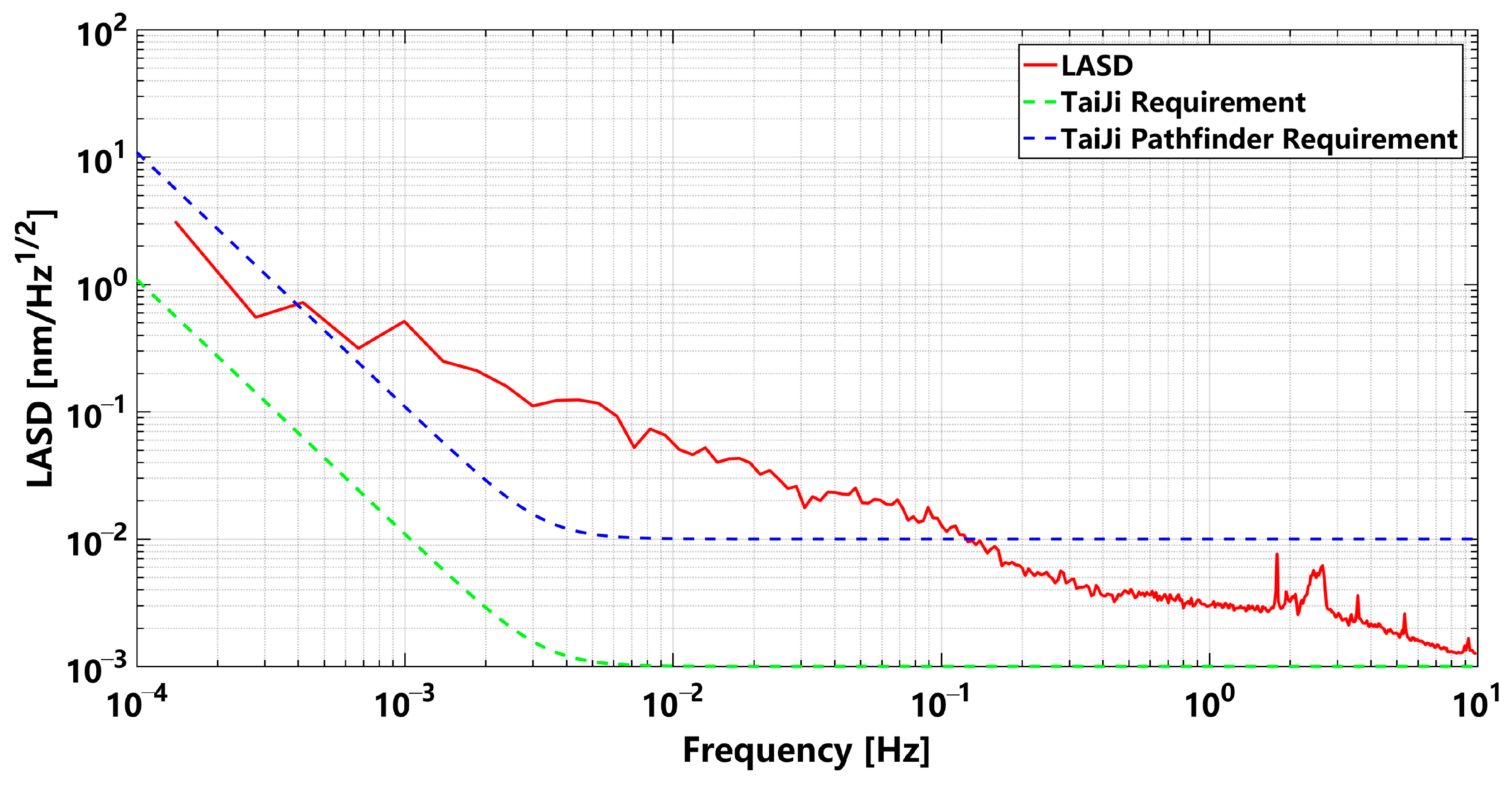
| Abbreviation | Full Name | Number |
|---|---|---|
| M | Mirror 1 | 5 |
| BS | Beam Splitter (R:T is 50:50) | 6 |
| BSa | Beam Splitter (R:T is 10:90) | 1 |
| BSb | Beam Splitter (R:T is 90:10) | 1 |
| BSc | Beam Splitter (R:T is 1:99) | 1 |
| BSd | Beam Splitter (R:T is 99:1) | 2 |
| PBS | Polarizing Beam Splitter | 3 |
| FIOS | Fiber Injector Optical Subassembly | 2 |
| P-A | Periscope 2 in side A | 9 |
| P-B | Periscope in side B | 9 |
| HWP | Half Wave Plate | 2 |
| QWP | Quarter Wave Plate | 2 |
| Telescope-I/F | Telescope Interface | 1 |
| TM-I/F | Test Mass Interface | 1 |
| PAAM | Point Ahead Angle Mechanism | 1 |
| BSMG | Beam Shrinking Mirror Group | 7 |
| QPD | Quadrant Photodiode | 7 |
Disclaimer/Publisher’s Note: The statements, opinions and data contained in all publications are solely those of the individual author(s) and contributor(s) and not of MDPI and/or the editor(s). MDPI and/or the editor(s) disclaim responsibility for any injury to people or property resulting from any ideas, methods, instructions or products referred to in the content. |
© 2023 by the authors. Licensee MDPI, Basel, Switzerland. This article is an open access article distributed under the terms and conditions of the Creative Commons Attribution (CC BY) license (https://creativecommons.org/licenses/by/4.0/).
Share and Cite
Tao, W.; Deng, X.; Diao, Y.; Gao, R.; Qi, K.; Wang, S.; Luo, Z.; Sha, W.; Liu, H. Design and Construction of the Optical Bench Interferometer for the Taiji Program. Sensors 2023, 23, 9141. https://doi.org/10.3390/s23229141
Tao W, Deng X, Diao Y, Gao R, Qi K, Wang S, Luo Z, Sha W, Liu H. Design and Construction of the Optical Bench Interferometer for the Taiji Program. Sensors. 2023; 23(22):9141. https://doi.org/10.3390/s23229141
Chicago/Turabian StyleTao, Wei, Xiaoqin Deng, Yuqing Diao, Ruihong Gao, Keqi Qi, Shaoxin Wang, Ziren Luo, Wei Sha, and Heshan Liu. 2023. "Design and Construction of the Optical Bench Interferometer for the Taiji Program" Sensors 23, no. 22: 9141. https://doi.org/10.3390/s23229141
APA StyleTao, W., Deng, X., Diao, Y., Gao, R., Qi, K., Wang, S., Luo, Z., Sha, W., & Liu, H. (2023). Design and Construction of the Optical Bench Interferometer for the Taiji Program. Sensors, 23(22), 9141. https://doi.org/10.3390/s23229141




